When you think of tequila, do shots and party drinks come to mind? While tequila is often associated with these festivities, there is a hidden world behind this beloved spirit. Authentic tequila from Mexico is not just a drink; it is a symbol of centuries-old craftsmanship, cultural significance, and the rich flavors of the agave plant.
What makes tequila truly authentic? How do traditional tequila distilleries in Mexico ensure the highest quality? And which tequila brands in Mexico are considered the best by experts and lovers of this spirit?
In this article, we will delve into the fascinating world of authentic tequila from Mexico. We will explore the origin and cultural significance of tequila, the regulations that ensure its authenticity, the impact of terroir on agave, and the traditional methods used in tequila production. We will also touch upon the difference between 100% agave tequila and mixto tequila, as well as the alcohol content of tequila in the U.S. versus Mexico.
Join me as we embark on a journey to discover the secrets behind authentic Mexican spirits and the top-rated tequila brands that produce handcrafted tequila straight from the heart of Mexico.
Key Takeaways:
- Authentic tequila from Mexico represents centuries-old craftsmanship and cultural significance.
- Tequila production is regulated by strict criteria and geographical designations.
- Terroir plays a significant role in the flavor profile of tequila, with different regions offering unique characteristics.
- Traditional tequila production involves harvesting agave, cooking, crushing, fermentation, and distillation.
- There are two main types of tequila: 100% agave tequila and mixto tequila.
Contents
- 1 The Origin and Cultural Significance of Tequila
- 2 Tequila Authenticity and Regulations
- 3 The Impact of Terroir on Agave
- 4 Tradition in Tequila Production
- 5 100% Agave Tequila vs. Mixto
- 6 Alcohol Content in the U.S. vs. Mexico
- 7 Suavecito is the Representation of Authentic Mexican Tequila
- 8 The Best Tequila Brands in Mexico
- 9 The Best Places to Try Tequila in Mexico
- 10 Conclusion
- 11 FAQ
- 12 Source Links
The Origin and Cultural Significance of Tequila
Tequila has a fascinating history that can be traced back to the ancient Aztecs. The Aztecs were the first to produce a fermented beverage called pulque from the sap of the agave plant. This primitive form of tequila laid the foundation for what would later become one of Mexico’s most beloved spirits.
It was not until the arrival of the Spanish conquistadors in the 16th century that a drink resembling modern tequila was developed. These early distillers took inspiration from the Aztecs’ pulque and began distilling agave in order to produce a stronger and more refined spirit.
Over time, the town of Tequila in the Jalisco region of Mexico became synonymous with the production of mezcal, the precursor to tequila. The volcanic soil and ideal climate created the perfect conditions for cultivating blue agave, the distinctive plant used in tequila production.
Tequila holds great cultural significance in Mexico and is deeply rooted in the country’s traditions and pride. It is a symbol of Mexican identity and craftsmanship, representing generations of knowledge and skill passed down through the ages.
The European influence on tequila cannot be overlooked. The Spanish introduced the distillation process and contributed to the development of tequila as we know it today. This fusion of European distillation techniques and indigenous Mexican ingredients is what makes tequila a unique and cherished spirit.
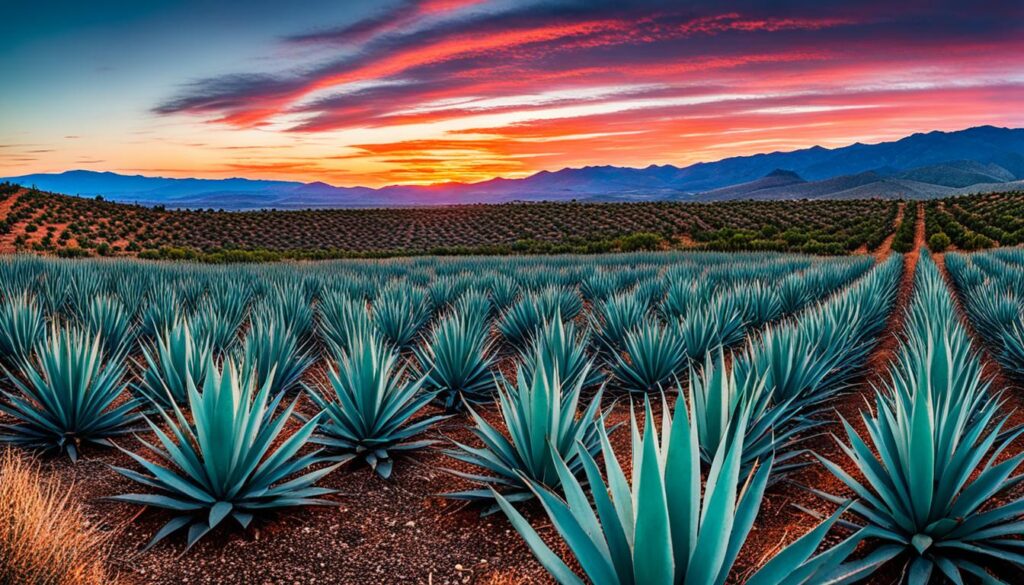
Tequila Authenticity and Regulations
To be considered authentic, tequila must adhere to specific regulations set by the Mexican government. These regulations determine the regions where tequila can be produced, the production criteria it must meet, and the quality standards it must uphold.
According to the Mexican tequila regulations, tequila can only be made and aged in certain designated regions. These regions include the entire state of Jalisco, as well as specific areas within Guanajuato, Michoacán, Nayarit, and Tamaulipas. By limiting production to these regions, the Mexican government safeguards the authenticity and quality of tequila.
The Consejo Regulador del Tequila (Tequila Regulatory Council) was established to oversee and enforce these regulations. This council ensures that tequila production adheres to strict standards, from the sourcing of agave to the aging process. Without the council’s certification, a tequila cannot be labeled as authentic tequila from Mexico.
“To protect consumers and preserve the integrity of tequila, the Mexican government has put in place regulations that dictate where and how tequila is made.” – Tequila Regulatory Council
These regulations not only preserve the cultural heritage and traditions associated with tequila but also maintain the high standard of quality that sets Mexican tequila apart from other spirits. By adhering to these regulations, tequila producers ensure that consumers can trust the authenticity and origin of the tequila they enjoy.
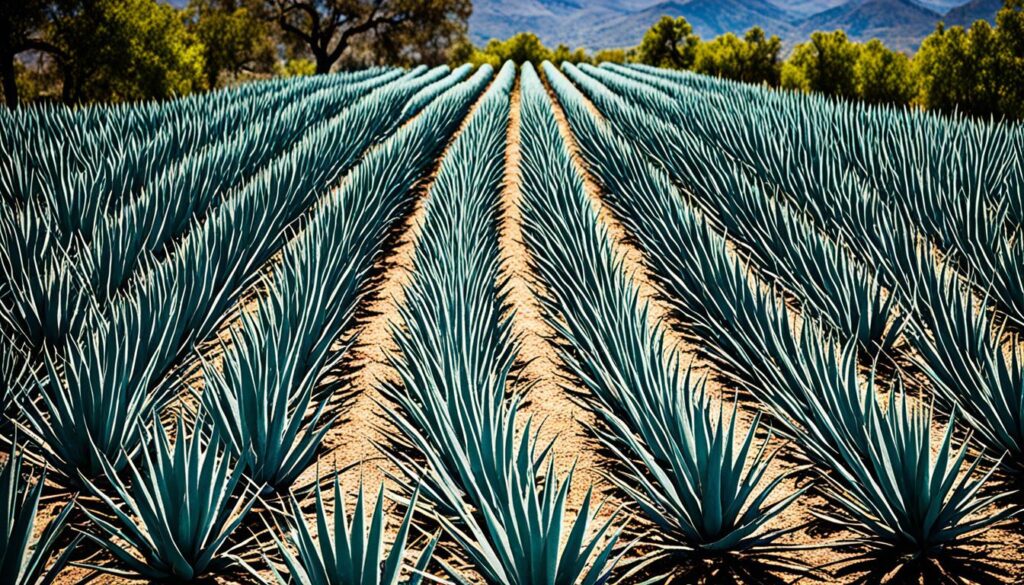
Authentic Tequila Regions
| Region | Description |
|---|---|
| Jalisco | The entire state of Jalisco is recognized as the main region for producing authentic tequila from Mexico. |
| Guanajuato | Designated areas within Guanajuato are authorized for tequila production. |
| Michoacán | Specific locations within Michoacán are recognized for producing authentic tequila. |
| Nayarit | Nayarit has designated areas where tequila can be produced according to the Mexican regulations. |
| Tamaulipas | Some regions within Tamaulipas are authorized for tequila production. |
By understanding and appreciating these regulations, tequila enthusiasts can confidently enjoy the authentic flavors and cultural heritage that define tequila from Mexico.
The Impact of Terroir on Agave
When it comes to tequila, the impact of terroir on agave cannot be underestimated. Terroir refers to the environmental factors, such as soil type, climate, and altitude, that influence the characteristics of a crop. In the case of tequila, the type of agave used and the terroir in which it is grown play a crucial role in the final flavor profile of the spirit.
Blue Agave: The Foundation of Tequila
The agave plant is the heart and soul of tequila production, and the blue agave (Agave tequilana) is the variety used exclusively for making tequila. This succulent plant thrives in the volcanic soil of Mexico’s tequila regions, absorbing the unique minerals and nutrients that contribute to its flavor.
Image: 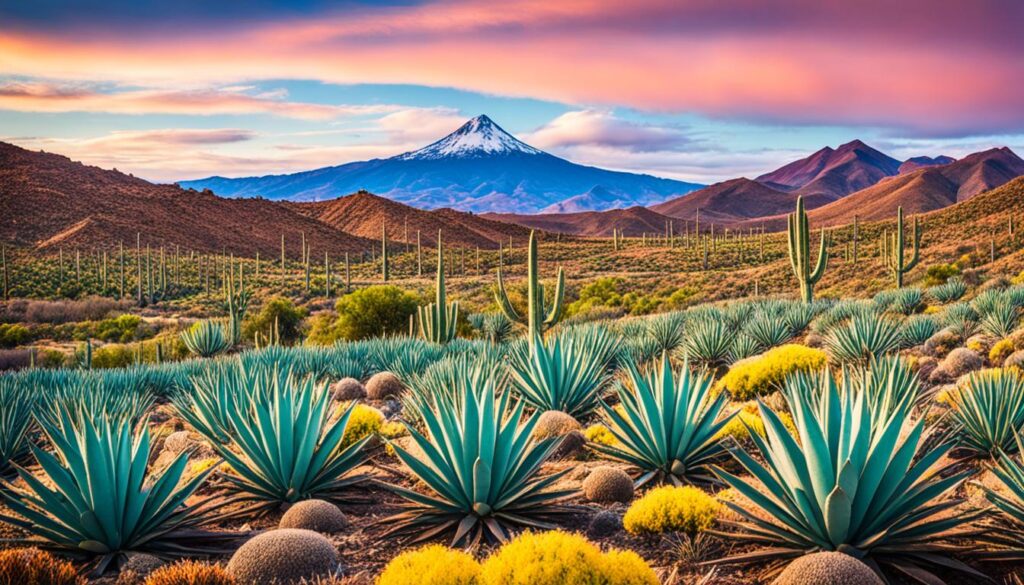
The Highland vs. Lowland Distinction
The two primary tequila-producing regions in Jalisco, Mexico, are the highlands (Los Altos) and the lowlands (Valles). These regions offer different growing conditions that impart distinct qualities to the agave and subsequently to the tequila produced.
| Highland Agave | Lowland Agave |
|---|---|
| Sweeter, fruitier flavors | Earthier, herbaceous flavors |
| Grown at higher elevations | Grown at lower elevations |
| Rich volcanic soil | Mineral-rich clay soil |
The highland agave, cultivated at higher elevations and benefiting from a cooler climate, develops a sweeter, fruitier flavor profile. The lowland agave, grown at lower elevations with warmer temperatures and mineral-rich clay soil, tends to produce tequila with earthier, more herbaceous flavors.
Adding Complexity and Variety to Tequila
The distinction between highland and lowland agave adds complexity and variety to tequila, offering consumers a range of flavor experiences. Whether you prefer the bright and fruity notes of highland tequilas or the earthy and herbaceous characteristics of lowland tequilas, the terroir of the agave plays a significant role in defining these flavor profiles.
By understanding the impact of terroir on agave, tequila enthusiasts can appreciate the diverse range of flavors that this iconic Mexican spirit has to offer. So, raise a glass and celebrate the rich cultural heritage that is tequila!
Tradition in Tequila Production
Traditional tequila production involves a series of carefully crafted steps that have been handed down through generations. These traditional tequila production methods play a vital role in creating the distinctive flavor and character of authentic tequila.
The first step in the tequila production process is the harvesting of the blue agave plants. Skilled laborers known as jimadors carefully select and harvest mature agave plants, ensuring that only the finest plants are used in the production.
Once the agave plants are harvested, the piñas, or hearts of the agave, are extracted and prepared for cooking. Traditionally, the piñas are cooked in large brick or stone ovens, giving the tequila its unique flavor profile.
After cooking, the piñas are crushed using a tahona, a massive stone wheel that grinds the agave into a pulp. This traditional method of crushing the agave helps extract the rich flavors from the plant.
The crushed agave is then left to ferment in open-air wooden vats. This natural fermentation process allows the sugars in the agave to convert into alcohol, contributing to the distinct taste of tequila.
Once the fermentation is complete, the tequila undergoes the distillation process. It is distilled in copper pot stills, which further refines the flavors and removes any impurities.
In some cases, tequila is aged in oak barrels during the tequila aging process. This aging process adds complexity and depth to the flavors, resulting in premium tequilas with rich, smooth characteristics.
This traditional approach to tequila production honors the centuries-old craftsmanship that has made tequila a symbol of Mexican pride and heritage. The attention to detail and focus on preserving the authentic flavors of the blue agave ensure that every bottle of tequila is a testament to the artistry and dedication of the tequila producers.
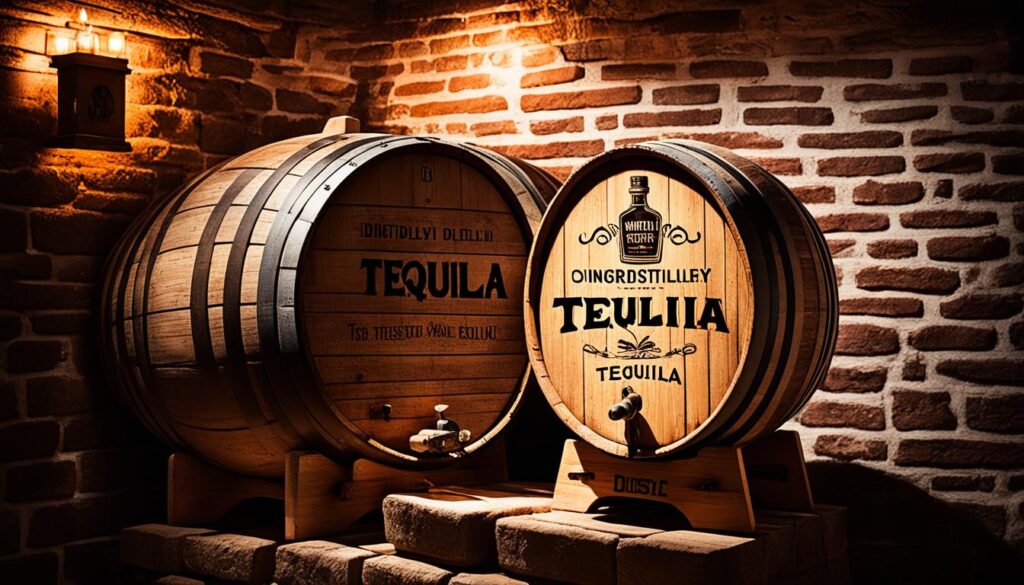
| Tequila Production Steps |
|---|
| Harvesting of blue agave plants by jimadors |
| Cooking of agave piñas in brick or stone ovens |
| Crushing of agave using a tahona |
| Fermentation in open-air wooden vats |
| Distillation in copper pot stills |
| Aging in oak barrels (optional) |
100% Agave Tequila vs. Mixto
When it comes to tequila, there are two main categories based on the content of agave sugars: 100% agave tequila and mixto tequila. Understanding the key differences between these types is essential for tequila enthusiasts and those seeking to truly appreciate the complexity and flavor of this Mexican spirit.
100% Agave Tequila
As the name suggests, 100% agave tequila is made entirely from fermented blue agave sugars. This means that every drop of the final product is derived from the sweet nectar of the blue agave plant. The result is a tequila that boasts a higher level of purity and a more distinct agave flavor profile.
Mixto Tequila
On the other hand, mixto tequila is made from a blend that includes at least 51% blue agave sugars, with the remaining percentage coming from other sugars. This can include sugarcane or corn syrup. Due to the inclusion of non-agave sugars, mixto tequila tends to have a slightly different taste compared to its 100% agave counterpart.
It’s important to note that mixto tequila can also include additives such as caramel coloring and sugar-based syrup, which can alter the taste and appearance of the tequila. This is something to consider for those who prefer a more pure and traditional tequila experience.
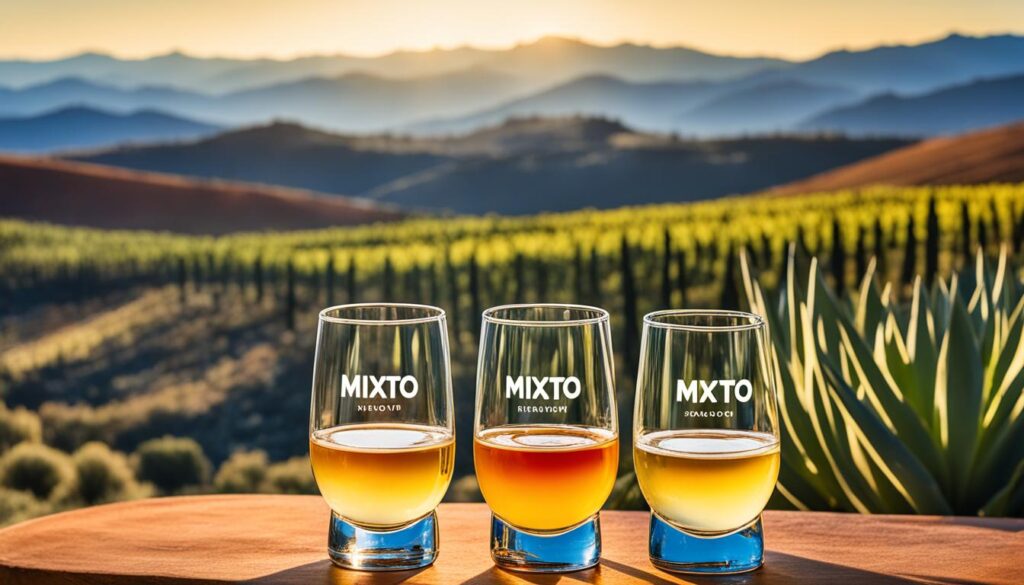
“100% agave tequila is often regarded as superior in quality due to its purity and tends to have a cleaner, more distinct agave flavor profile.”
Ultimately, the choice between 100% agave tequila and mixto tequila comes down to personal preference and the desired flavor experience. Whether you appreciate the uncompromising purity of 100% agave tequila or enjoy the unique characteristics of mixto tequila, both offer a wide range of options to explore and enjoy.
Alcohol Content in the U.S. vs. Mexico
When it comes to tequila, the alcohol content can vary depending on where it is produced. In the United States, the standard alcohol content for spirits is 40% (80 proof). This is the benchmark for alcoholic beverages, including tequila. However, in Mexico, authentic tequila traditionally has a lower alcohol content of 35% (70 proof).
The difference in alcohol content does not indicate inferior quality in Mexican tequila. Instead, it reflects the preference and standards of tequila production in Mexico. The lower alcohol content allows for a smoother and more nuanced drinking experience, showcasing the true flavors of the agave plant.
It’s important to note that some major tequila brands have increased the alcohol content in order to meet the expectations of American consumers. These brands may offer tequilas with 40% alcohol content to align with the U.S. standard. However, many regional tequilas produced in Mexico still adhere to the traditional 70 proof standard.
| Country | Alcohol Content | Proof |
|---|---|---|
| United States | 40% | 80 proof |
| Mexico | 35% | 70 proof |
As seen in the table above, the difference in alcohol content between the U.S. and Mexico can impact the overall drinking experience of tequila. While both versions offer unique qualities, the lower proof of Mexican tequila allows for a smoother, more nuanced flavor profile.
Now that we understand the differences in alcohol content, let’s explore Suavecito, an authentic Mexican tequila brand that stays true to the traditional 70 proof standard.
Suavecito is the Representation of Authentic Mexican Tequila
Suavecito is an example of an authentic Mexican tequila brand that embodies the Mexican tequila craftsmanship. Made from blue agave grown in the Jalisco highlands, Suavecito follows time-honored techniques to ensure the highest quality. With an alcohol content of 70 proof, Suavecito stays true to the traditional standards of Mexican tequila. It offers a robust flavor that is a testament to tequila’s storied past. Suavecito provides an opportunity to experience the authenticity and rich history of tequila.
When it comes to choosing an authentic tequila brand, Suavecito stands out for its commitment to preserving the Mexican tequila craftsmanship. Their attention to detail in every step of the production process ensures that every bottle of Suavecito tequila delivers an exceptional experience.
“Suavecito tequila is crafted with utmost care, using the finest ingredients and traditional techniques. Our dedication to preserving the traditions of Mexican tequila craftsmanship has allowed us to create a tequila that truly captures the essence of our heritage.”
By selecting only the best blue agave grown in the Jalisco highlands, Suavecito ensures that their tequila carries the authentic flavors and aromas that make Mexican tequila so renowned. The agave is carefully harvested by skilled jimadors, who have perfected their craft over generations.
Once harvested, the agave piñas, or hearts, are cooked in traditional brick or stone ovens, creating a deep and complex flavor profile. The cooked piñas are then crushed using a tahona, a large stone wheel, which extracts the sweet juices from the agave fibers.
Following the crushing, the juice is left to ferment in open-air wooden vats, allowing nature to contribute its unique flavors to the final product. This traditional fermentation process results in a tequila that is rich in character and smooth on the palate.
After fermentation, the tequila undergoes distillation in copper pot stills, ensuring the removal of impurities and the preservation of the authentic flavors. The tequila is then bottled, ready to be enjoyed by tequila enthusiasts around the world.
Suavecito tequila represents the culmination of centuries-old Mexican tequila craftsmanship, offering a taste of the authentic flavors and cultural heritage associated with tequila. Whether sipped neat, mixed in a cocktail, or enjoyed with friends, Suavecito tequila delivers an experience that honors the traditions and artistry of Mexican tequila production.
| Brand | Agave Source | Production Region | Alcohol Content |
|---|---|---|---|
| Suavecito | Jalisco Highlands | Jalisco | 70 proof |
In the vibrant world of tequila, Suavecito stands as a shining example of an authentic Mexican tequila brand. Its commitment to preserving the rich traditions of Mexican tequila craftsmanship sets it apart and makes it a must-try for tequila enthusiasts seeking a genuine and exceptional experience.
The Best Tequila Brands in Mexico
Mexico is home to some of the best tequila brands in the world. When it comes to tasting the finest tequilas, these Mexican brands are at the top of the list. Whether you’re a seasoned tequila connoisseur or just starting to explore this spirited world, these recommendations will surely awaken your taste buds. Here are five tequila brands that have gained international recognition for their exceptional quality and diverse range of flavors:
- El Jimador
- Don Julio
- Tequila Herradura
- Tequila Ocho
- El Patrón
These Mexican tequila brands are known for their commitment to craftsmanship and producing tequilas that showcase the true essence of Mexico’s beloved spirit. Each brand offers a variety of tequilas, from the crisp and vibrant blanco to the rich and complex añejo. With their distinct flavor profiles, there’s a tequila for every palate.
| Tequila Brand | Tequila Types | Flavor Profile |
|---|---|---|
| El Jimador |
|
A smooth and well-balanced tequila with hints of citrus and caramel. |
| Don Julio |
|
A sophisticated tequila with notes of agave, vanilla, and oak. |
| Tequila Herradura |
|
A rich and full-bodied tequila with hints of caramel and spices. |
| Tequila Ocho |
|
A complex tequila with unique flavors influenced by its terroir. |
| El Patrón |
|
A bold and smooth tequila with notes of oak, vanilla, and agave. |
Whether you’re sipping it neat, enjoying a margarita, or using it in cocktails, these tequila brands offer remarkable experiences in every bottle. Discover the diverse flavors and find your favorite among these esteemed Mexican tequila brands.
The Best Places to Try Tequila in Mexico
If you’re visiting Mexico, you don’t want to miss out on the incredible tequila tasting experiences that the country has to offer. From tequila tours and distillery visits to immersing yourself in the Mexican tequila tourism scene, there are plenty of options to explore. Here are a few of the best places to try tequila in Mexico:
- Casa Mission, Cozumel Island: Located on picturesque Cozumel Island, Casa Mission offers free tequila tours where you can learn about the production process and taste tequila straight from the source. This immersive experience allows you to witness the craftsmanship that goes into creating authentic tequila while enjoying the beautiful surroundings of the island.
- Royal Hideaway Playacar, Playa del Carmen: If you’re staying in Playa del Carmen, make sure to visit the tequileria bar at the Royal Hideaway Playacar hotel. Here, you can indulge in tequila cocktails crafted by expert mixologists, attend masterclasses on tequila history, and enhance your knowledge of this beloved spirit. It’s the perfect place to unwind and savor the flavors of Mexico.
Whether you’re traveling solo or with a group, a tequila tasting experience in Mexico is an unforgettable way to immerse yourself in the rich culture of tequila. From learning about the production process to trying different tequila varieties, these destinations offer a true taste of Mexican tequila craftsmanship.
The Tequila Tasting Experience at Casa Mission
When you visit Casa Mission on Cozumel Island, you’ll be treated to an informative and engaging tequila tasting experience. The tour takes you through the entire tequila production process, from harvest to bottling, giving you a behind-the-scenes look at how this iconic Mexican spirit is made.
“The tequila tasting at Casa Mission was truly eye-opening. I learned so much about the different flavor profiles and aging processes of tequila. The staff was incredibly knowledgeable and passionate, and their love for tequila really shone through.” – Sarah, tequila enthusiast
At the end of the tour, you’ll have the opportunity to sample a variety of tequilas, each with its own unique characteristics. From smooth and floral blanco tequilas to rich and complex añejo tequilas, there’s something to suit every palate.
| Tequila Type | Flavor Profile |
|---|---|
| Blanco | Light, crisp, and citrusy |
| Reposado | Smooth, caramel, and vanilla notes |
| Añejo | Rich, complex, and oaky |
Whether you’re a tequila aficionado or just starting your tequila journey, Casa Mission’s tequila tasting experience is a must-try. It’s an opportunity to deepen your appreciation for tequila and discover new flavors and aromas you may have never experienced before.
So, when you’re in Mexico, make sure to add tequila tasting to your itinerary. It’s an unforgettable way to explore the rich history and cultural significance of this iconic Mexican spirit.
Conclusion
Tequila, a spirit deeply rooted in Mexican heritage, offers more than just a shot or a party drink. It is a symbol of tradition, craftsmanship, and the essence of agave. Throughout this article, we have uncovered the origin and cultural significance of tequila, delved into the regulations that ensure its authenticity, explored the impact of terroir on agave flavors, and learned about the traditional methods of tequila production. We have also examined the distinction between 100% agave tequila and mixto tequila, and discussed the alcohol content variations between tequilas in the U.S. and Mexico.
By understanding the intricacies of tequila, one can truly appreciate the complexity and authenticity of this beloved Mexican spirit. Whether you prefer the sweeter notes of highland agave or the earthy flavors of lowland agave, there is a tequila out there to suit every palate. So, raise a glass of authentic tequila from Mexico, savor its unique flavors, and immerse yourself in its vibrant world.
In conclusion, tequila is not just a drink, but a journey into Mexico’s rich cultural heritage. From the ancient Aztecs to the Spanish conquistadors, this spirit has evolved over centuries, embodying tradition, craftsmanship, and the natural beauty of the agave plant. So, next time you sip on a glass of tequila, remember the artistry and dedication that goes into producing this authentic Mexican spirit. Cheers!